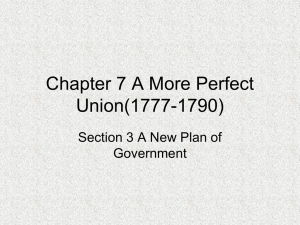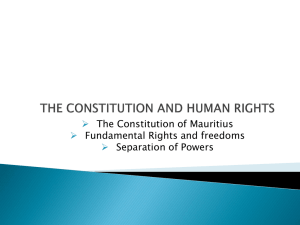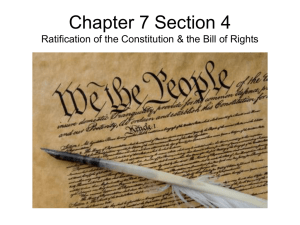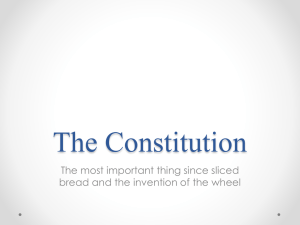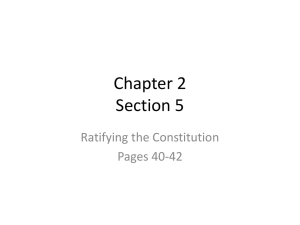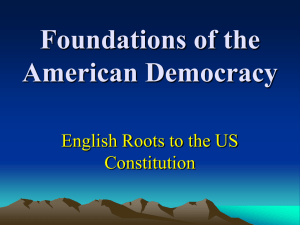Chapter 2
advertisement
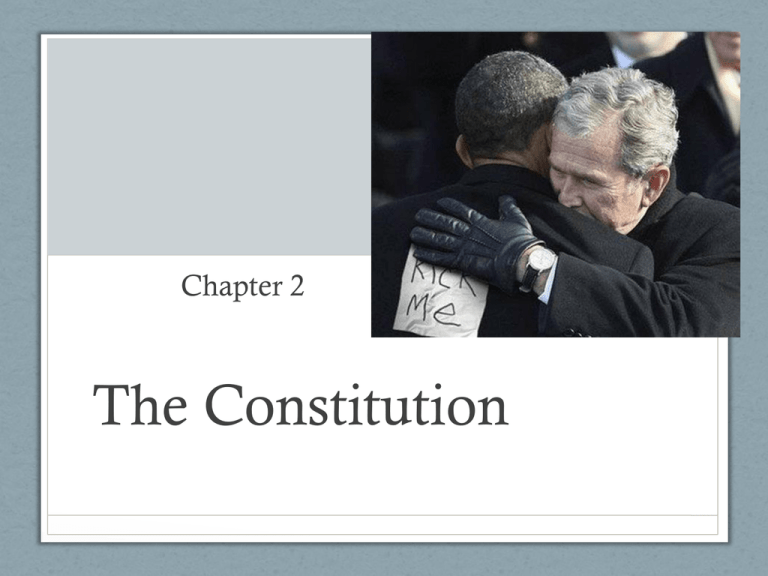
Chapter 2 The Constitution Political Philosophy • John Locke’s Natural Rights philosophy states: • the government’s role is to protect life, liberty and property • Consent of the governed • Limited government protects natural rights. Revolution • The American Revolution represents an overthrow of a system of government based on widespread popular support. • It did not cause widespread societal change like the Russian, Chinese, or Iranian revolutions. The Government That Failed • The Articles of Confederation • The first document to govern the United States. • Established a confederation among 13 states. • Why a Confederation? • Unitary system provided a tyranical parliament • Congress had few powers; no president or national court system. • Most government power rested in the states…. They wanted Sovereignty The Government That Failed • Economic Turmoil • Postwar depression left farmers unable to pay debts • Shays’ Rebellion • Series of attacks on courthouses by a small band of farmers led by Revolutionary War Captain Daniel Shays to block foreclosure proceedings. • Economic elite concerned about Articles’ inability to limit these violations of individual’s property rights. Economic strife showed the national gov’t couldn’t protect its citizens. • Failed Annapolis Convention, 1786. Sources of the Constitution A.Colonial experiences, e.g., power of elected assembly. B. State constitutions written after the Declaration of Independence, e.g., Preamble closely resembles the introduction to the Mass. Constitution. C. Experiences under Articles of Confederation, e.g., lack of power to tax and regulate currency and interstate commerce. D. British customs and traditions, e.g., Magna Carta and English Bill of Rights. Making a Constitution: The Philadelphia Convention • Gentlemen in Philadelphia • 55 men from 12 of the 13 states (RI not there) • Mostly wealthy planters & merchants • Most were college graduates with some political experience • Many were coastal residents from the larger cities, not the rural areas “Well-read, well-bred, well-fed, and well-wed.” • Madison • “Father of Const.” because of leadership and detailed notes of proceedings. • Brilliant advocate for strong national government…initial plan • Washington • presiding officer; chosen unanimously • Franklin • “elder statesman.” • Morris • largely responsible for final wording of Const. • Hamilton • most forceful advocate for strong central government. Areas of agreement 1. Scrap the Articles of Confederation. 2. Establish a republican govt. 3. Establish a constitutional govt. 4. Establish a balanced govt. where no single interest dominated. 5. Suffrage for property owners only. 6. Stronger central govt. than under the Articles. 7. Protection of property rights. 8. 1 State=1 Vote…simple majority rules The Philadelphia Convention, continued • Assumptions • Human Nature is selfinterested • Political Conflict leads to factions • Objects of Government include the preservation of property • Nature of Government sets power against power so that no one faction rises above and overwhelms another The Constitution The new Constitution needed to answer 5 Q’s. . . a) How should the government rule? b) Who should rule? c) How will the people participate equally? d) How to keep factions from establishing a tyrannical environment? e) How to keep government from becoming too tyrannical? – Equality Issues: Representation Equality Issues: Other Compromises • Slavery • Three-fifths compromise (taxes and represent) • Ending Slave Trade • Slaves are not specifically mentioned in the Constitution, but there is a reference to persons “not free. • Voting Requirements were left to the states. • Election of the President • Life term v. annual election --- > compromise of a 4-year term. • Method of election: • Congress v. state legislatures v. direct election • Compromise: Electoral College system. Economic Issues • States had tariffs on products from other states • Paper money was basically worthless (14 currencies) • Congress couldn’t raise money The Agenda in Philadelphia Individual Rights Issues • Some were written into the Constitution: Prohibits suspension of writ of habeas corpus No bills of attainder No ex post facto laws Religious qualifications for holding office prohibited • Strict rules of evidence for conviction of treason • Right to trial by jury in criminal cases • • • • • Some rights were not specified • But were we being ruled by “men” or by laws? • To protect us from these “men” the Bill of Rights would be added to protect us from gov’t. . .a recollection of all the ills that the colonists resented under British rule. The Madisonian Model • To prevent a tyranny of the majority, Madison proposed a government of: • • • • Limiting Majority Control Separating Powers Creating Checks and Balances Establishing a Federal System The Madisonian Model • The Constitution and the Electoral Process The Madisonian Model Outline of Constitution • Article 1: Legislative Branch (12, 14) • Article 2: Executive Branch (13, 14) • Article 3: Judicial Branch (4, 5, 16) • Article 4: Interstate Relations (3) • Article 5: Amending the Constitution (2) • Article 6: Debts, Supremacy, Oaths (3) • Article 7: Ratifying the Constitution (2) Ratification Two Sides • Federalists • Without a national Gov. Anarchy would triumph. • Only a strong Nat. Gov. Can protect the new nation against foreign enemies. • Bill of rights not necessary because 8 states already had written constitutions • Anti-Federalists • Demanded a bill of rights • Were afraid of central authority infringing individual liberties. • Extralegal (not sanctioned by law) only authorized to revise Articles. • Criticized for being drafted in secrecy. Federalist Advantages • Were better represented in state legislatures. • Controlled the press. • Began ratification procedures quickly before Antifederalists could get organized. Ratifying the Constitution • Federalist Papers • A collection of 85 articles written by Alexander Hamilton, John Jay, and James Madison under the name “Publius” to defend the Constitution • Bill of Rights (12 Proposed) • The first 10 amendments to the U.S. Constitution, drafted in response to some of the AntiFederalist concerns about the lack of basic liberties Federalist Papers Madison, Hamilton, and Jay—get the Constitution ratified!!! Federalist 10 Factions will unite to pursue selfish goals—NOT THE NATIONAL INTERESTS Control factions— 1) destroy liberty citizens the same opinions/passions 2)give all Greatest cause of factions—UNEQUAL DISTRIBUTION of PROPERTY If minority—remove by regular majority vote If in majority– large republic will help disperse factions by balancing them Federalist 51 • Key to maintaining separation of powers lies in checks and balances • Because man has a lust for power, must pit branches against each other for control • Each branch must be checked in accordance with its power • THEREFORE—divide inherently powerful legislature and strengthen executive Federalist 78 • Written by Hamilton to explain the structure of the Judiciary Branch • Believed the courts should have the power of judicial review • Believed it would be the weakest of the three because it had "no influence over either the sword or the purse, ...It may truly be said to have neither FORCE nor WILL, but merely judgment." • Believed the judiciary would not be able to overpower the political branches • Congress controls the money flow • The President controls the military • Courts do not have the same clout from a constitutional design standpoint. The judiciary depends on the political branches to uphold its judgments. • Believed the judiciary was the "least dangerous" branch. • Believed federal judges should retain life terms as long as they exhibit good behavior. Ratifying the Constitution • Ratification • 9/13 states were needed to ratify. • Lacking majority support, the Federalists specified that the Constitution be ratified by state conventions, not state legislatures. • New Hampshire’s approval (the ninth state to ratify) made the Constitution official six months later. Changing the Constitution formally • Legacy of Articles • Unanimous vote to amend ---> impractical --> desire to make process easier, but not too easy. • Reasons for recent popularity of proposing Amendments (e.g., balanced budget, D.C. statehood, ERA). • Dissatisfaction by interest groups with court decisions. • Gridlock in Congress. • Time limits for ratification • generally 7 years (exception of ERA and the 27th). Formal Constitutional Change Informal Constitutional Change • Judicial Interpretation • Marbury v. Madison (1803): judicial review • Changing Political Practice/Parties • Technology • Increasing Demands on Policymakers The BILL OF RIGHTS -amendments #1-10 1. Freedom of • • • • • Religion Speech Press Gather together Petition the government 2. Right to own a gun 3. Right not to have soldiers live in your house Continued 4. Right to not to have the police search you or your belongings unreasonably or without cause 5.Right to not incriminate yourself, be charged with the same offense twice, and right to have due process 6.Right to speedy criminal trial, have a jury in a criminal trial 7.Right to have a jury in a civil trial Conclusion 8. Freedom from cruel and unusual punishment 9. Rights specifically listed in the Constitution (federal) shall not limit the rights in the Constitution (state) or the people. Constitutional rights do not deny other rights. 10.Powers not specifically listed in the Constitution for the federal government are given to the states. Summary • The Constitution was ratified to strengthen the powers of the national government. • Protection of individual rights guaranteed through the Bill of Rights. • Formal and informal changes continue to shape our Madisonian system of government. Six Principals of Constitution • Judicial Review • Checks and Balances • Separation of Powers • Federalism • Limited Government • Popular Sovereignty


